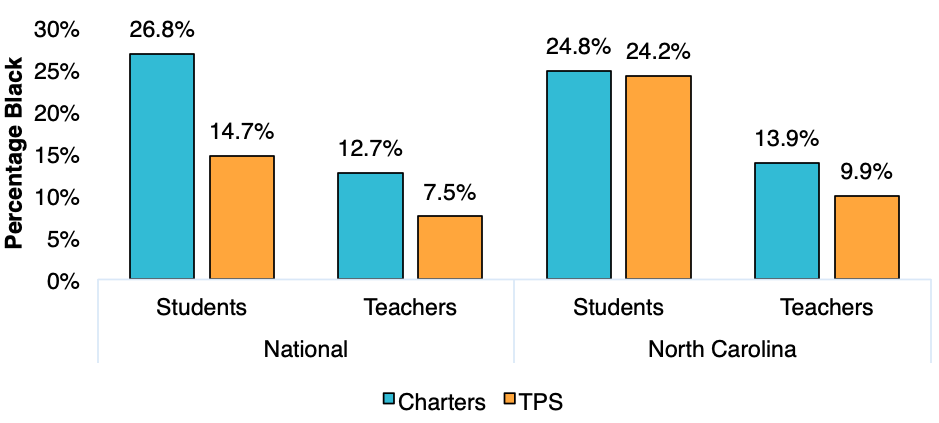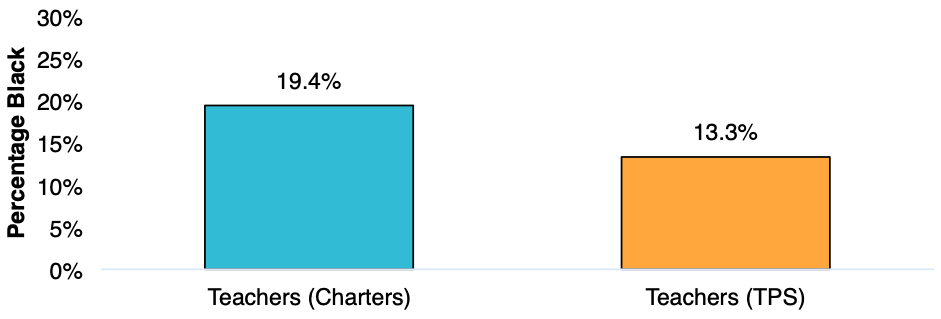Last week, we at Fordham released a new study called Student-Teacher Race Match in Charter and Traditional Public Schools. Authored by Seth Gershenson, Associate Professor at American University, it finds that black students in charter schools in North Carolina are about 50 percent more likely to have a same-race teacher than their black counterparts in traditional public schools, that the impact of having a same-race teacher is twice as large in charter schools as in traditional public schools, and that within charter schools, the effect of having a same-race teacher is about twice as large for nonwhite students as for white students.
In light of these findings, some have criticized Fordham with inappropriately generalizing the results from the Tar Heel State to charter and traditional public schools across the country. The study itself was careful not to do so. Yet the national data we have indicate that the charter advantage in teacher diversity holds far beyond North Carolina.
Dr. Gershenson chose to use North Carolina for a reason. His work here is but the most recent entry in a growing body of literature exploring student-teacher race match, a significant portion of which examines data from the state. As the study notes, this is partly because of data availability, but also because:
North Carolina is a large and diverse state, whether one looks at its socioeconomic composition, its demographics, or its topography. While its student body is slightly poorer and more racially diverse than the United States as a whole, the state’s public school system generally resembles those of many other large states. Moreover, results of education studies in North Carolina tend to align with those using nationally representative data, suggesting that results are often generalizable outside of the Tar Heel State.
To be sure, the report acknowledges that North Carolina is different in some ways from the country at large, and that its “checkered racial history and atypical charter population” warrants caution in applying the study’s findings beyond the state’s borders. So we can’t say, and didn’t say, that all of the results are generalizable to America’s charter schools writ large.
We do, however, think the report findings are worth the consideration of a national audience because they are indicative of broader patterns. For example, one of the key findings of the report is that charter schools employ a more diverse teacher workforce than traditional public schools. Using national data from the 2016–17 National Center for Education Statistics National Teacher and Principal Survey we find that, although the racial composition of students attending North Carolina’s charter schools is different than the national picture, teacher diversity in charters is greater than in traditional public schools in both cases (see Figure 1).
Figure 1. Percentage of black students and black teachers in charter and traditional public schools nationally and in North Carolina

Sources: 2016–2017 National Teacher and Principal Survey, U.S. Department of Education; Seth Gershenson, Student-Teacher Race Match in Charter and Traditional Public, Thomas B. Fordham Institute (June 2019).
In North Carolina, 24.8 percent of charter students are black, versus a slightly smaller 24.2 percent in traditional public schools. Nationally, the gap is larger, at 26.8 percent and 14.7, respectively. And the pattern for teacher diversity is similar: 13.9 percent of Tar Heel State charter teachers are black, compared to just 9.9 percent of their district peers. Nationwide, these percentages are 12.7 and 7.5 percent, respectively.
Still, it might not be fair to compare charter schools to all traditional public schools because, nationally, charters are more highly concentrated in urban areas and are known to serve more minority students.
Yet when we restrict the sample of schools nationwide to those that serve mostly children of color, we find that charters still employ a more diverse teacher workforce, even though the difference narrows considerably. According to data from the same national survey, 19.4 percent of such charter schools’ full-time teachers are black, versus 13.3 percent in traditional public schools. This 46 percent difference is comparable to what we found for North Carolina. And the trend is similar for Hispanic teachers: 17.8 percent and 13.7 percent for charters and traditional public schools, respectively (see Figure 2).
Figure 2. National percentage of black teachers in schools with minority student enrollment of 50 percent or higher

Source: 2016–2017 National Teacher and Principal Survey, U.S. Department of Education.
No matter how you slice it, the teacher workforce is more diverse in charters than traditional public schools—both in North Carolina and across America. Because charter schools also serve a larger proportion of minority students, this means their students of color are probably more likely to be taught by a same-race teacher, though we can't analyze this directly using the national data that are available.
Yes, our latest report only uses data from North Carolina. But many studies examining differences between charters and traditional public schools have used data from one locale because restrictions in data availability make national and even regional analysis extremely difficult to conduct.
Moreover, our findings aren’t the final word on any of these issues; no research ever is. Yet the results are suggestive. Researchers should use the findings as a springboard for further analysis and see if our findings do actually hold true in other states. Educational leaders of all kinds should seek ways to improve teacher diversity. And traditional public school administrators should learn from and emulate some of the ways charter schools hire more teachers of color. It’s the children who will benefit.



